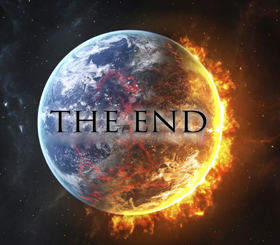Click here to listen to this article:
 Whether one is considering the false teachings of the AD 70 doctrine, or the false claims of the Jehovah’s Witnesses (and with them the more recent “New Creation” theologians) a pivotal question in how one interprets eschatological language is when it must be taken literally and when it figuratively represents an important moment of divine judgment. Pertinent to this point is the question of whether the Old Testament ever clearly foretells an ultimate and final destruction of the present cosmos. If not, those who would interpret New Testament claims of an end of the world as figurative can appeal to Old Testament language as the antecedent and precedent to such conclusions. If not, in a similar way, those who believe in a future eternal rejuvenated state of the present cosmos can see in Old Testament prophesies of a lion dwelling with the lamb type imagery a picture of the future hope of the righteous on this world. If, however, the Old Testament does indicate that this universe is finite and temporary one cannot dismiss all eschatological language as figurative nor necessarily compare the hope of eternal life too closely with conditions in this present world.
Whether one is considering the false teachings of the AD 70 doctrine, or the false claims of the Jehovah’s Witnesses (and with them the more recent “New Creation” theologians) a pivotal question in how one interprets eschatological language is when it must be taken literally and when it figuratively represents an important moment of divine judgment. Pertinent to this point is the question of whether the Old Testament ever clearly foretells an ultimate and final destruction of the present cosmos. If not, those who would interpret New Testament claims of an end of the world as figurative can appeal to Old Testament language as the antecedent and precedent to such conclusions. If not, in a similar way, those who believe in a future eternal rejuvenated state of the present cosmos can see in Old Testament prophesies of a lion dwelling with the lamb type imagery a picture of the future hope of the righteous on this world. If, however, the Old Testament does indicate that this universe is finite and temporary one cannot dismiss all eschatological language as figurative nor necessarily compare the hope of eternal life too closely with conditions in this present world.
 One doesn’t have to look far to see an answer to this question. After the flood God declared, “While the earth remains, seedtime and harvest, cold and heat, winter and summer, and day and night shall not cease” (Gen. 8:22, NKJV). The wording here is compelling, although most English translations render this with a dynamic equivalency rather than literal wording. The Hebrew uses the adverb ôd meaning “as long as,” before the words “all the days.” God literally promises “as long as all the days of the earth” seasons and day and night will not cease. To refer to something with the qualifier “while” or “as long as” necessarily infers that there will be a time when the earth will not remain (or literally when “all the days” of earth are completed. Could this refer to an ongoing rejuvenated earth? No. An explicit condition of the “new earth” in the age to come is the promise “there shall be no night there” (Rev. 21:25; cf. 22:5). That makes it clear that the “new earth” is not the same earth of God’s promise after the flood.
One doesn’t have to look far to see an answer to this question. After the flood God declared, “While the earth remains, seedtime and harvest, cold and heat, winter and summer, and day and night shall not cease” (Gen. 8:22, NKJV). The wording here is compelling, although most English translations render this with a dynamic equivalency rather than literal wording. The Hebrew uses the adverb ôd meaning “as long as,” before the words “all the days.” God literally promises “as long as all the days of the earth” seasons and day and night will not cease. To refer to something with the qualifier “while” or “as long as” necessarily infers that there will be a time when the earth will not remain (or literally when “all the days” of earth are completed. Could this refer to an ongoing rejuvenated earth? No. An explicit condition of the “new earth” in the age to come is the promise “there shall be no night there” (Rev. 21:25; cf. 22:5). That makes it clear that the “new earth” is not the same earth of God’s promise after the flood.
The prophets are unquestionably where most of the eschatological language of the Old Testament can be found. In many cases such “end times” language is not literal, but a figurative way of describing a great act of God’s judgment. For example, God reveals to Isaiah a time when He “will shake the heavens, and the earth will move out of her place” (Isa. 13:13)—a time when the stars “will not give their light; the sun will be darkened in its going forth, and the moon will not cause its light to shine” (Isa. 13:10). We can know that these things are not talking about the end of time because the chapter begins identifying this as a “burden against Babylon” (Isa. 13:1). This type of textual indicator shows that the language is either figurative or foreshadowing future events while declaring a more immediate judgment.
 When indicators such as this are not present we must be careful not to assume too quickly that the Holy Spirit is leading the prophet to speak figuratively. A good example of this is Isaiah 51:6. The Lord declared, “Lift up your eyes to the heavens, and look on the earth beneath. For the heavens will vanish away like smoke, the earth will grow old like a garment, and those who dwell in it will die in like manner; but My salvation will be forever, and My righteousness will not be abolished.” In this text the Lord compares His enduring salvation and righteousness with the heavens, the earth, and even the inhabitants of earth. Some might argue that since “those who die on it” (i.e. human beings) do not face annihilation when they die, if human death is in “like manner” to the fate of the heaven and earth then they too will not face annihilation. The comparison, however, can only go so far. Man does not face annihilation because he has an inner being (i.e. the soul or spirit) that does not “vanish away” in the death of the body. Unless we accept a “mother-earth” or animistic concept that attaches consciousness to inanimate creation we cannot argue that the heavens and earth possess an eternal inner nature. That being the case, we must recognize that this text clearly proclaims a finite existence to the present cosmos, which will one day “vanish away” and “grow old like a garment.”
When indicators such as this are not present we must be careful not to assume too quickly that the Holy Spirit is leading the prophet to speak figuratively. A good example of this is Isaiah 51:6. The Lord declared, “Lift up your eyes to the heavens, and look on the earth beneath. For the heavens will vanish away like smoke, the earth will grow old like a garment, and those who dwell in it will die in like manner; but My salvation will be forever, and My righteousness will not be abolished.” In this text the Lord compares His enduring salvation and righteousness with the heavens, the earth, and even the inhabitants of earth. Some might argue that since “those who die on it” (i.e. human beings) do not face annihilation when they die, if human death is in “like manner” to the fate of the heaven and earth then they too will not face annihilation. The comparison, however, can only go so far. Man does not face annihilation because he has an inner being (i.e. the soul or spirit) that does not “vanish away” in the death of the body. Unless we accept a “mother-earth” or animistic concept that attaches consciousness to inanimate creation we cannot argue that the heavens and earth possess an eternal inner nature. That being the case, we must recognize that this text clearly proclaims a finite existence to the present cosmos, which will one day “vanish away” and “grow old like a garment.”
These two texts make it clear that the Old Testament does prophesy a time when the present heaven and earth will end, but there is one powerful text that we must consider which leads some to deny this. The preacher, in the book of Ecclesiastes proclaims, “One generation passes away, and another generation comes; but the earth abides forever” (Ecc. 1:4). Does this passage teach that the earth will continue forever? We must remember the phrase that sets the focus of the book of Ecclesiastes—“under the sun” (Ecc. 1:3, 9, 14). This phrase is found 27 times in the twelve chapters of this short book. Many have suggested (I believe properly) that this indicates a specific focus on matters as they appear in this world, not as they really are. This focus is clear in matters like vanity. It is not actually true that “all is vanity” (Ecc. 1:2), but “under the sun” that is how it often appears. In matters like death it is not actually true that “the dead know nothing” and “have no more reward” (Ecc. 9:5), but once again, “under the sun” that is how it can appear. The Preacher in this same way, while considering things “under the sun” declares that the earth appears to abide forever, in contrast to the passing of one generation after another, but that doesn’t demand that we understand that the earth will actually abide forever. In light of the previous statements, and their expansion in the New Testament we must conclude that the present heavens and earth are not eternal, but will one day be destroyed upon the Lord’s return in the final judgment (cf. 2 Pet. 3:1-13).
Kyle Pope
Amarillo, TX
kmpope@att.net
For Further Study:
Sermon: Some Scriptures on the Second Coming and the End of the World Audio | PPT
Article: “Laid Bare” or “Burned Up” PDF

